Writing w/Strangers: A Poetry for the People in Philadelphia
You a poet / man?
Uh-huh, uh-huh
Me too.
—Etheridge Knight
Sixteen years ago, I was a disenchanted grad student living in West Philly in a second-floor row house apartment. Mark (now my husband) and I lived on a block with plenty characters and some real folks. People like Brother Vance—with his baby locs and his makeshift bookcases full of vinyl—who would move in and move on after a few months. And others, like the Falcons—Larry (“The Rev”) and Jubilee School Karen and their kids—who had been there longer than a minute. Hanging out on the sidewalk as the sun went down and the streetlights came on, The Rev often told us about his Cajun roots and the river that used to run below 43rd Street, right under our feet.
I would leave West Philly everyday to go study poetry in classes stiff with competition and sophisticated tests of my self-esteem. In the evenings, I would frequent poetry venues where the poems sounded like Broadway auditions or soft drink commercials. Between these two worlds, I was trying to hold on to my belief that poetry was free for all and didn’t require tuition, a cover charge, a two-drink minimum, or an entourage. I had to agree with Philly poet Ewuare Osayande, who railed against that time in his book So the Spoken Word Won’t Be Broken: The Politics of the New Black Poetry, that there was something more to poetry than “begging to the green genie for the three wishes of fame, fortune and favor” (Osayande 23).
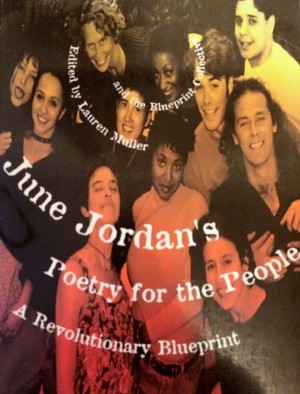
There used to be a Borders at 18th and Walnut Streets in Center City where you could find Theodore Harris with a fresh collage or Lamont Steptoe at a café table surrounded by disciples. It was there I found, like a wayfaring stone, June Jordan’s Poetry for the People: a revolutionary blueprint. I didn’t know about the radical black woman poet, playwright, essayist, activist, and teacher June Jordan when I first started reading the book, which outlined her groundbreaking poetry program at the University of California, Berkeley. Poetry for the People (which is still operating as an arts/activism program within the Department of African American Studies at Berkeley) was an academic class that blossomed into student-led campus and community readings, workshops, and anthologies. The book, co-authored by Jordan and nine of her students who made up “The Blueprint Collective,” was an offering,
…a blueprint for poetry for the people: a testament, a manual, an anthology of new poems and new bibliographies, and an open case history. It is an academic experiment soaring past campus boundaries. It is a political movement that anybody anywhere can join, imitate, or improve. It is a literary movement that no one can stifle or erase. (Jordan 3-4)
It was like that book fell out of the sky (or through the roof of Borders) and smacked the grad school funk right out of me. And so it came to be that in the Prince-tinged year of 1999, Y2K brewing on the horizon, I put the Collective’s “blueprint” to work in West Philly.
The Rev let us use his space on Chestnut Street, a storefront church called Toviah’s. During the week, one side of the building operated as a thrift store; on Sundays, the other half, with its cross on the wall and its upright piano in the back, became sacred space. Starting that fall, we hosted poetry readings at Toviah’s on the last Tuesday of every month. The readings were always free, and we provided childcare and a meal to those who needed it. Mark made the beans (no pork), I made the rice, and my girl Cathleen Miller, made a mean chocolate cake. The people who showed up—students, A-Space folks, artists, neighbors fighting the encroaching university, Phyllis from the projects over by Powelton, and some little kids who needed extra attention—were a real motley crew of poets who would sign-in with names like “Little Grasshopper,” “Vultura,” and “WKOT.” That first reading in the thrift-store church, a small group of us read “Georgia Dusk” like a psalm. In Philadelphia, even with its blocks brimming with the refuge of holy storefronts, there was a profound need and yearning for this kind of poetry sanctuary.
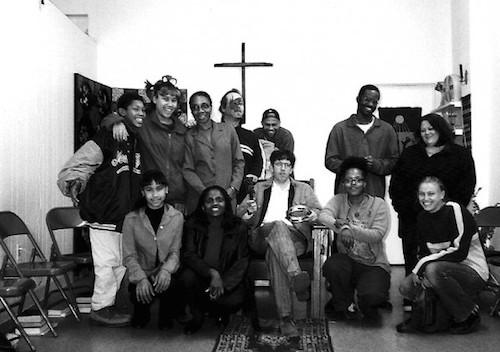
We called ourselves Poetry for the People Philadelphia (P4P, Poetry 4 the Peeps), and our kick-ass mission was simple: “embrace all art forms in order to celebrate poetry…to make poetry accessible because we believe it is necessary in everyday life. By creating a space where all are encouraged to participate, we aim to remove art from its commercial purposes and return it to the people.” In October 1999, we orchestrated a reading on the Market-Frankford Subway-Elevated Line also called The El. About ten of us met at 46th and Market Streets at seven o’clock in the morning. We rode the El downtown to 2nd Street Station and back again, taking turns blending in, reading poems and handing out flyers inspired by the look of transportation schedules. Check out Ross Gay spitting this early version of "Let Me Be" or Magdalena Zurawski reading "Ballad of the Concrete Tree." We got some chile-please, near-angry looks, but we also got plenty love. Like when we pulled into 30th Street, and an elderly woman wearing a babushka said from her seat, “It’s nice to have a little verse in the morning.” Listening to the audiocassette of that day, I’m tickled by who we were—all brand-new and brave—and who we’ve all become. There were some heavy-hitting poets getting/getting us elevated underground that day—Gay, Zurawski, Martin Wiley, Nijmie Dzurinko, and Heather Rion Starr. It’s not really a surprise to me that they/we are all still riding this “for the People” train of thought and action through the fields of environmental ethics, ministry, teaching, youth organizing, and media justice.
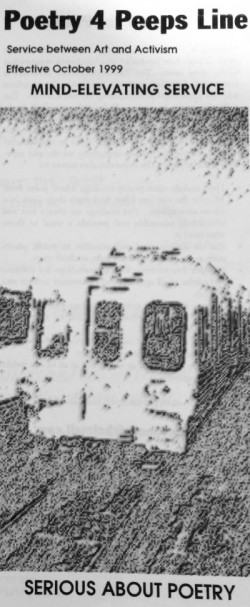
Next we took our guerilla poetry tactics into the supermarket and onto the sidewalk with chalk. On Christmas Eve that year, we went poetry caroling along Baltimore Avenue, performing choral versions of poems like “Midwinter Blues” by Langston Hughes: “’Twas the night befo’ Christmas/My good man turned me down” (Hughes 65). A woman outside of West City Video said, “That was the weirdest caroling I’ve ever heard.” “What the hell was that!” exclaimed a man outside Sam’s Place. We wrapped up the evening with a reading and open mic at a safe house for women and children fleeing abuse.
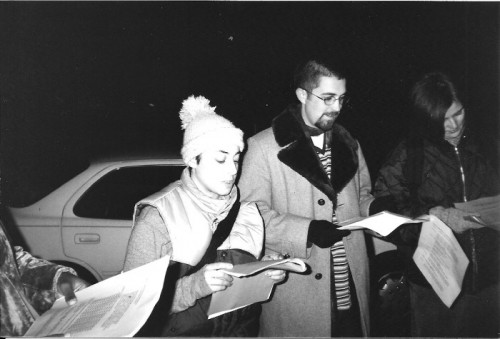
In addition to leading a clothing drive for back-to-work programs at poetry venues around Philly during National Poetry Month 2000, we hosted readings and workshops at local libraries. We often used the Exquisite Corpse format to create collaborative poems with diverse groups of people. In these community spaces, it was both thrilling and humbling to be regarded as a poet, teacher, neighbor, and comrade, all in one body. As a group, we worked excitedly to find the sweet spot of engagement and communion, planting seeds of intentionality and purpose within the structure of our workshop plans but also leaving space for something magical to happen. Those seeds and magic eventually became the roots of my practice as a community-based poet and educator.
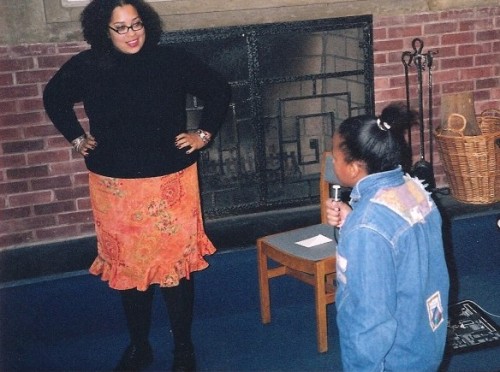
We had big P4P Philly dreams: We wanted to publish a yearly anthology of work by community poets of all ages. We wanted to provide training and support to poets looking to become active in their communities. But we didn’t last. Folks graduated. Some people left Philly. We got jobs. I didn’t learn about stuff like grant-writing and strategic planning until much later. But I like to think we were on to something. That we created space for newer, more sustainable, similarly people-centered Philly literary movements like Apiary and PYPM.
In Poetry for the People: a revolutionary blueprint, The Blueprint Collective acknowledges Leslie Simon, a woman who founded a program under the same name at San Francisco City College. That P4P ran from 1955 to 1984, and the poets read their work in city parks and in the county jail. (Muller et al viii). Must be a reason that this slogan keeps coming back like a mantra, a resurrected refrain that never dies. We will always need a “poetry for the people” because so often poetry ain’t for nobody/no body but school, the journals, the critics, and the awards.
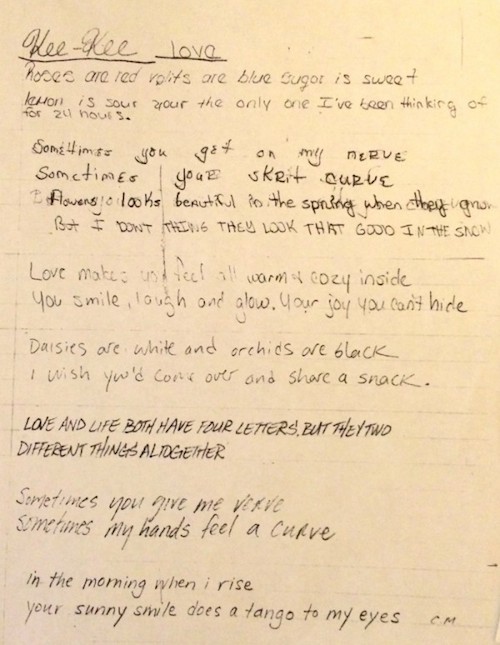
As a poet living in the City of Murals and the birthplace of the Philadelphia Sound, it’s hard for me not to ask: Can poetry be public art? Can poetry change the face and the soul of the city? Whenever I doubt it (which isn’t often or for too long), I go back to these early experiences/experiments in Philly with Jordan’s blueprint in my back pocket. In The Life of Poetry, Muriel Rukeyser talks about the fear of poetry, how we are taught to make poetry precious in school, but we aren’t taught how to use it. (Rukeyser 13-14). What she wrote then in 1949 rang true for me fifty years later in 1999 and still applies today. But thank goodness for June Jordan who taught me—a black woman poet struggling to find meaning and purpose in my MA program—how to put poetry to use. Good use. In the-city-of-not-enough-brotherly-love, I have “used” the power of poetry to inspire connection and healing among strangers, newbies, connoisseurs, and cynics. And I still believe deeply in Jordan’s odds: “…anyone who becomes a practicing poet has an excellent chance of becoming somebody real, somebody known, self-defined, and attuned to and listening and hungering for kindred real voices utterly/articulately different from his or her own voice” (Jordan 8). Yes, indeed, June. I believe there’s a poetry for everybody, and it will lead you to a tribe of your own making.
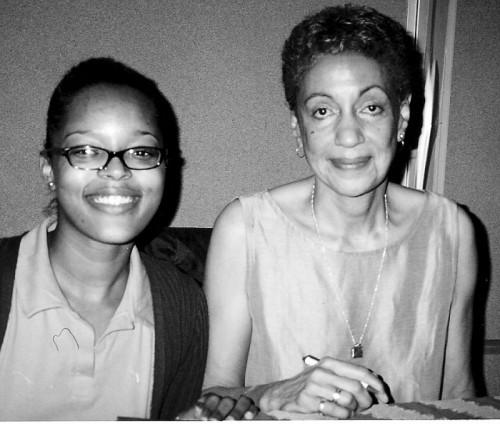
For the P4P Philly Crew 1999-2000: Cher, Pia Deas, Nijmie Dzurinko, Larry Falcon, Ross Gay, Laura Goldstein, Tonya C. Hegamin, Cathleen Miller, Mark Palacio, Jamar Pettis, Heather Rion Starr, Martin Wiley, Jacqueline Wigfall, & Magdalena Zurawski.
Works Cited:
Hughes, Langston. “Midwinter Blues.” The Collected Poems of Langston Hughes. Ed. Arnold Rampersad and David Roessel. New York: Vintage Books, 1994. 65. Print.
Jordan, June. Introduction. June Jordan’s Poetry for the People: a revolutionary blueprint. Ed. Lauren Muller and the Poetry for the People Collective. New York: Routledge, 1995. 1-9. Print.
Knight, Etheridge. “On the Projects Playground.” The Essential Etheridge Knight. Pittsburgh: University of Pittsburgh Press, 1986. 108. Print.
Muller, Lauren, and The Poetry for the People Collective, eds. June Jordan’s Poetry for the People: a revolutionary blueprint. New York: Routledge, 1995. Print.
Osayande, Ewuare. So the Spoken Word Won’t be Broken: The Politics of the New Black Poetry. Philadelphia: Talking Drum Communications, 1999. Print.
Rukeyser, Muriel. The Life of Poetry. 3rd ed. Massachusetts: Paris Press, 1996. Print.
Poet Yolanda Wisher was born in Philadelphia and raised in North Wales, Pennsylvania. She earned a BA...
Read Full Biography

